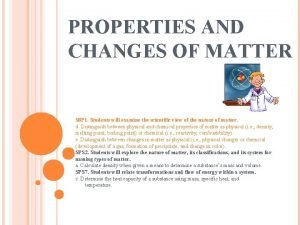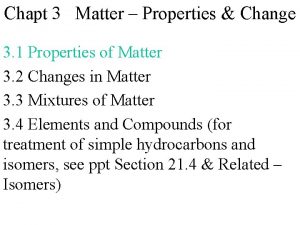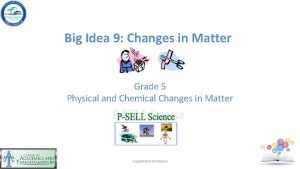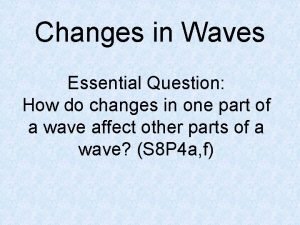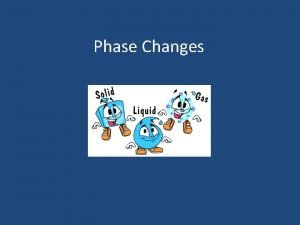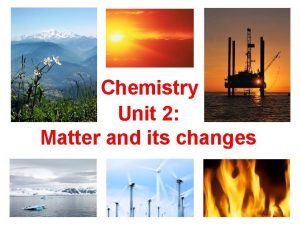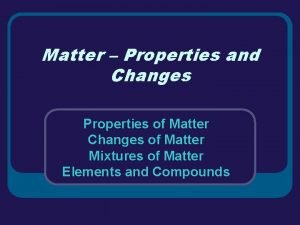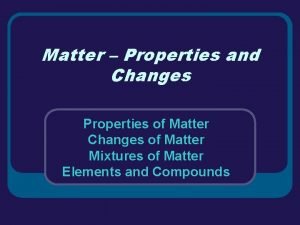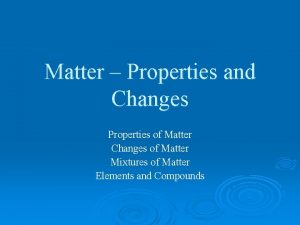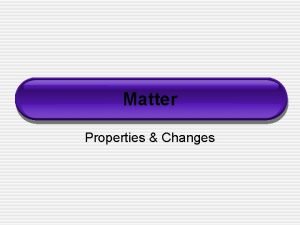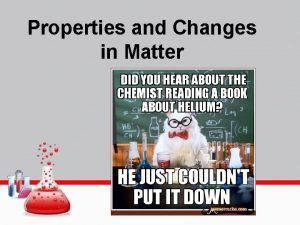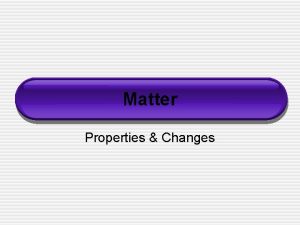Unit 2 Matter III Properties Changes in Matter












- Slides: 12

Unit 2 - Matter III. Properties & Changes in Matter (p. 11 -14) w Extensive vs. Intensive w Physical vs. Chemical C. Johannesson

A. Extensive vs. Intensive ö Extensive Property w depends on the amount of matter present ö Intensive Property w depends on the identity of substance, not the amount C. Johannesson

A. Extensive vs. Intensive ö Examples: w boiling point intensive w volume extensive w mass extensive w density intensive w conductivity intensive C. Johannesson

B. Physical vs. Chemical ö Physical Property w can be observed without changing the identity of the substance ö Chemical Property w describes the ability of a substance to undergo changes in identity C. Johannesson

B. Physical vs. Chemical ö Examples: w melting point physical w flammable chemical w density physical w magnetic physical w tarnishes in air chemical C. Johannesson

B. Physical vs. Chemical ö Physical Change w changes the form of a substance without changing its identity w properties remain the same ö Chemical Change w changes the identity of a substance w products have. C. Johannesson different properties

Physical Changes in Matter ö change in a substance that doesn’t change the identity of the substance ö Ex. grinding, cutting, melting, boiling ö Can be reversible, or irreversible ö Includes all changes of state (physical changes of a substance from one state to another)

Chemical Changes in Matter ö a change in which a substance is ö ö converted into a different substance same as chemical reaction doesn’t change the amount of matter present reactants- substances that react products- substances that form ö Arrow points from the reactants to the new products

B. Physical vs. Chemical ö Signs of a Chemical Change (Reaction) w change in color or odor w formation of a gas (bubbling or fizzing) w formation of a precipitate (solid) w change in light or heat C. Johannesson

Conservation of Mass ö During any chemical reaction, the mass of the products is always equal to the mass of the reactants. ö All the mass can be accounted for: w Burning of wood results in products that appear to have less mass as ashes; where is the rest? ö Law of conservation of mass

In the pictures how do you know right away that a chemical change took place? reactants = product 43. 43 g Original mass = 43. 43 g Final mass

B. Physical vs. Chemical ö Examples: w rusting iron chemical w dissolving in water physical w burning a log chemical w melting ice physical w grinding spices physical C. Johannesson
 Properties and changes of matter worksheet
Properties and changes of matter worksheet Matter-properties and changes answer key
Matter-properties and changes answer key Big idea 9 changes in matter
Big idea 9 changes in matter Elizabeth mulroney
Elizabeth mulroney Example of physical and chemical change
Example of physical and chemical change Hamlet act iii scene ii
Hamlet act iii scene ii Changes in wave properties sorting activity answer key
Changes in wave properties sorting activity answer key Chemical properties and changes lesson 4
Chemical properties and changes lesson 4 Physical/chemical changes & properties color by number
Physical/chemical changes & properties color by number Physical changes of matter
Physical changes of matter 5 phases of matter
5 phases of matter Definition of substance
Definition of substance Change in state of matter
Change in state of matter
